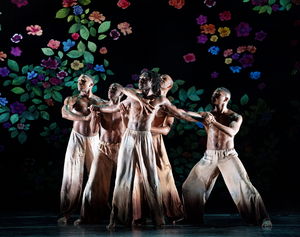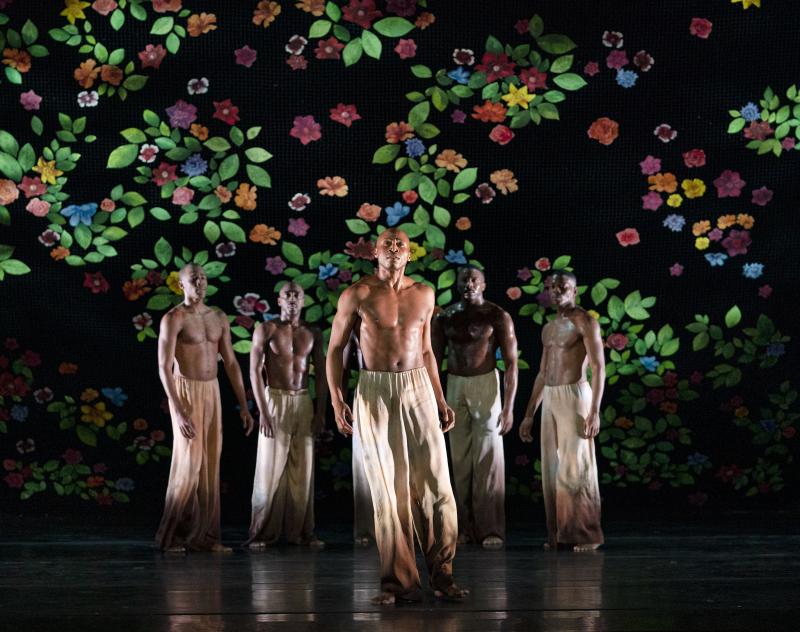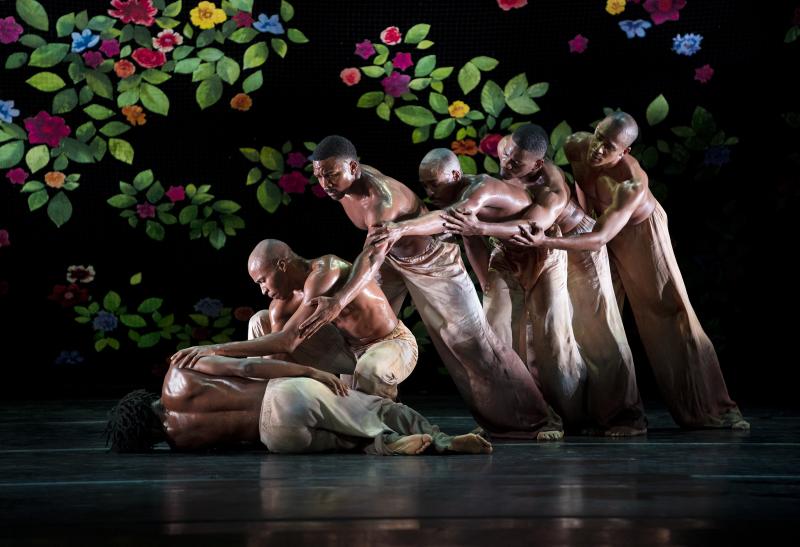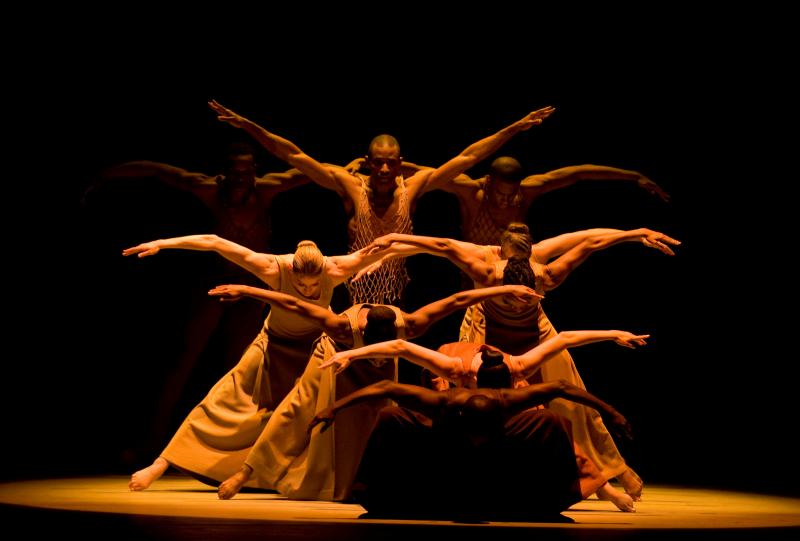Review: Alvin Ailey American Dance Theater Salutes The Ailey School with Tremendous Dancing

Paul Kolnik; photographer
Let's settle this right off the bat: Alvin Ailey American Dance Theater's December 10th tribute to The Ailey School's 50th anniversary was the greatest night of dance that I have experienced in over two years.
Following artistic director Robert Battle's customary charming remarks--and off-script evisceration of anyone who dares to mock boys who want to dance--the evening opened with a momentous revival of Memoria, which Ailey choreographed in 1979 to honour the "wild spirit" of his beloved friend, Joyce Trisler.
For many years I considered Memoria a dull affair. That changed last night due in no small part to the entire company's stellar dancing. Jacqueline Green evoked a celestial goddess in the central role, performing as if she were Donna Wood reborn, while Akua Noni Parker floated through the secondary woman's part with the amplitude of a coloratura soprano easily dispatching Casta Diva's every silvery line. Clifton Brown and Yannick Lebrun beamed like coruscating shafts of light as Green's framing partners and James Gilmer held steady as the solo man who faces off towards the ensemble, hovering in arabesques longer than seemed possible or transforming his legs into arrows that extended unwaveringly towards eternity.
.jpg)
Steve Wilson; photographer
This company-wide technical brilliance was only one aspect of what affected an alchemical shift in my decades long indifference towards the ballet. For the first time ever, I detected an unshakeable intentionality reigning throughout the piece. During a post performance conversation, former Ailey star Sarita Allen confirmed that this revival felt special: "I'm giving it the highest compliment possible," she explained. "I felt Alvin's spirit onstage." Perhaps it was the school's anniversary that invoked that transformation, though I'd hazard Masazumi Chaya's forthcoming retirement was the likely source of rejuvenation.
Chaya has mentored the company as associate director for over 28 seasons and it seems that the dancers have decided that every last moment with him is to be treasured. Whether an actual pact was made or not, his staging of the ballet's opening swirling bodies was infused with the same devotion that one recognizes in the ballerinas of George Balanchine's Serenade as they strike tendu. Rather than simply muscle past Memoria's many technical challenges, the company knit through their array of impossible balances as if they were tree branches swaying gently in a summer breeze. Adding The Ailey School's students to the revolving panorama--with a pilgrimage line, four corner pinwheel, and a rush of bodies towards the center--elevated the feeling of deep spirituality while also introducing an element of mirth. These dancers were thrilled to show their mettle, and struck out boldly as if to put all on notice that they were for hire (and are coming for your jobs).
Dancing frequently on her own as the Trisler figure, Jacqueline Green cut through any semblance of solemnity with a vigorous sweetness to her attack. Changing out of her gossamer robes, she charged the stage as a vision in red, leaping towards a diagonal stream of criss-crossed students who retreated to allow her passage. Soon the entire company returned as whirling revelers, free of Hades and ready for spring. If Serenade ends in transcendence, then Memoria continues like a Black funeral service: resounding joyfully in celebration for one who was passed but whose remembrance remains a galvanizing force.
The evening's eagerly anticipated premiere, Ode, is Jamar Roberts' first ballet for the company since his appointment as resident choreographer. Much like Kyle Abraham's commission from two year ago, this ballet--a tribute to victims of senseless gun violence--is receiving a three season unveiling. Unlike Abraham's contribution, Roberts' work communicates what it is about without relying upon obvious text. The only clue of what the ballet might entail was a net of flowers hanging as a backdrop, similar to a mural of art or arrangements of flowers left at the site of one who has died in a tragic accident. In my mind, it also felt like a nod to Ophelia flowing down the river Lethe in a bed of flowers.

Paul Kolnik; photographer
Ode opened with Chalvar Monteiro twitching awake from out of a huddled mass on the floor into a coccyx balance (a reference to Ailey's I Wanna Be Ready?) as swells of Don Pullen's Suite (Sweet) Malcom (Part 1 Memories and Gunshots) wafted in the background. Renaldo Maurice, Solomon Dumas, Yannick Lebrun, and Michael Jackson, Jr wandered in from both sides of the stage and began a ripple of movement that waxed through their grouping in unison, canon, and solos. Suddenly Jeroboam Bozeman stormed in and began a spiky solo punctuated by jags of accents in the music. He was a shaman, leading the dancers in a ritual of convulsing movement that could have been boys shooting the breeze on a playground.

Paul Kolnik; photographer
Roberts illustrated great musical sophistication by arranging the dancers in circling pairs and trios of unison, with Renaldo Maurice frequently initiating a movement sequence in solo counterpoint. Soon, all six dancers were toiling in their own solos, caught in a loop of reliving the lives that late they might have led. Here they worked themselves into a sweaty frenzy until bursts of clarion percussion struck, rendering them numb as Bozeman sliced experimentally between each shred of sound. What followed was an excruciatingly long sequence that made me hate the ballet as the five stood in stasis waiting for some unseen occurrence. After a deluge of movement audiences usually need a moment of respite to reset and process. But not like this: with frenetic blitzes of sound engulfing the stage but little in the way of action. I felt as if an unassailable force were holding me down and slowly pinching me in unexpected places. It reminded me of being caught in a shoot out in Harlem years ago; captive, hyper aware of every passing moment, and afraid to die. Thankfully all six dancers began moving again, thrashing then pausing to frame Bozeman who traveled forward while beckoning for someone to embrace him.

Paul Kolnik; photographer
Throughout Ode, I noticed a tenderness amongst its men that one rarely witnesses in the media's depiction of Black men. It was nurturing rather than sexual or violent. Two questions came to mind as I watched: "Why can't I be me?" and "What if we could just be beautiful?" The overall effect was like watching the souls of five men who were cut down too soon, offer comfort and brotherhood to Chalvar Montiero who looked as if he were on the verge of joining their ranks. After a final tableau vivant, they faded, leaving Montiero alone in his opening huddle. The emotional extremes I underwent while watching this Ode--alternating between whimsy, joy, curiosity, anger, resentment, frustration, fear, and hostility--were unlike anything I've ever experienced in previously. I remain deeply conflicted, though curious about the next installation. Perhaps that is the highest compliment that one can pay any piece of art.

Nan Melville; photographer
The evening closed with a fantastic performance of Revelations. Highlights included Jermaine Terry--a marvelous dancer in want of proper coaching and better casting--partnering Sarah Daley-Perdomo in Fix Me, Jesus with a calm and steady approach that cast a uniquely simmering afterglow. With this performance he revealed the leading man that he could be if given the chance. Solomon Duman and Belén Indhira Pereyra gave the Take Me to The Water sequence a jaw dropping performance, with Dumas utilizing every scintilla of the music like a jazz musician relaxing on the back beat. Famed Horton-technique teacher Milton Myers has frequently said that the side sways in this section are meant to resemble fields of wheat blowing in the wind; Dumas' performance summoned both the wheat and the church. Akua Noni Parker was wonderful in Rocka My Soul in The Boson of Abraham; if only she would dance the umbrella woman with that same abandon. It was wonderful to see Vernard Gilmore holding down the fort as the central man in Rocka My Soul. His clucking shoulders, deep backbends, subtle shimmies, and pump steps rendered him a living masterclass of the ballet. Students from the school joined the performance again, this time in the aisles of the theatre dressed like their counterparts onstage. The effect was endearing though difficult to take in while also keeping an eye on the main action.

Donna Ward; photographer
On the downside, the dancers need to review Revelations' Graham contractions and pretzels, and take a look at how the women use their church fans. Celeste Spears and Khalia Campbell had the correct grip, but everyone else took to flapping their hands instead of cracking the wrists. And though he is a lovely dancer, James Gilmer's lack of familiarity with the Horton and Graham techniques came through in the ways that he phrased Sinnerman's movements: as academic postures. Surely he will get better, but as of now he is 100 years too early to be in this part.
AAADT's theme this year is Ailey Revealed. After experiencing a performance like last night's one yearns for another 1000 years of revelations. In keeping with honouring the affiliated school's anniversary, with over 10 new members having recently joined the ranks--eight of whom studied or graduated from the school--and at least two more due to arrive next season, it feels comforting to know that there is a clear pipeline for keeping the company strong. Here's to continuing that vision of strength in 2020.
Reader Reviews

Videos


